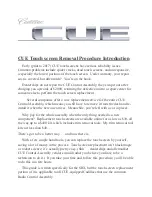
A-1
Appendix A
Summary of Specifications
Uncertainty Analysis
To perform an Uncertainty Analysis on a measurement device, you must be able to
identify all of the parameters that influence the measurement. You must be able to
quantify the magnitude of the potential error source and combine these into an overall
uncertainty statement.
To determine the expanded uncertainty on any manufacturers pressure Transfer Standard
(TS), you must identify the following four primary influences;
1.
Performance specifications of the TS
2.
Long term Stability of TS
3.
Uncertainty of the standard used to calibrate the TS
4.
Environmental or installation influences that could cause errors in the TS
Performance Specifications
Performance specifications are the short-term measurement properties of the device.
These traditionally include linearity, hysteresis, and repeatability properties of the
transfer standard. There often is considerable confusion with the performance
specification because different manufacturers use different terms to describe the
performance characteristics of their instruments. The two most common terms used are
“Accuracy” and “Precision”. In both cases, as a minimum the manufacturers define these
terms to be the combined effects of linearity, hysteresis and repeatability. Since the
manufacturer defined the terms they used, this should not be a problem. However, it is
common that the users definition of these terms differ from the manufacturers and
therefore cause considerable confusion. For instance, the user may believe that the term
“Accuracy” includes all sources of uncertainty. This would include items 1 through 4
listed above which would be an all encompassing specification. The manufacturer may
define “Accuracy” as the performance specification which consists only of item 1 above.
The result would be that the instrument would not be capable of meeting the user’s
application because it would not meet the users definition of “Accuracy”.
Long Term Stability
Long term stability defines how the instrument drifts with time. This specification can be
utilized to define the calibration interval for the standard. Some manufacturers will
provide more than one stability specification for their instrument based on different
calibration time intervals. It is important to understand that you should not arbitrarily
vary the manufacturers stability specification based on time without knowing the
Summary of Contents for RUSKA 7050
Page 3: ...7050 Change Language Hold key for 5 seconds mode enter...
Page 4: ......
Page 10: ...RUSKA 7050 7050i 7050LP Users Manual vi...
Page 12: ...RUSKA 7050 7050i 7050LP Users Manual viii 7 1 Packing the PPI 7 3...
Page 18: ...RUSKA 7050 7050i 7050LP Users Manual 1 6...
Page 32: ...RUSKA 7050 7050i 7050LP Users Manual 3 4...
Page 60: ...RUSKA 7050 7050i 7050LP Users Manual 5 14...








































